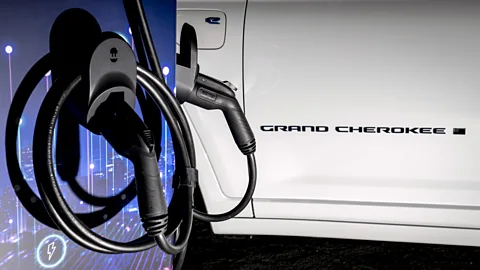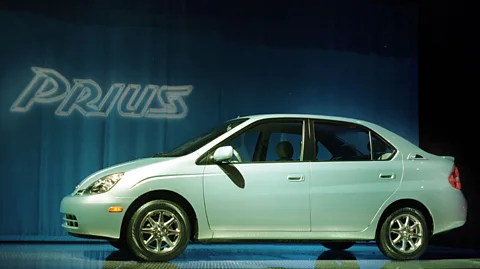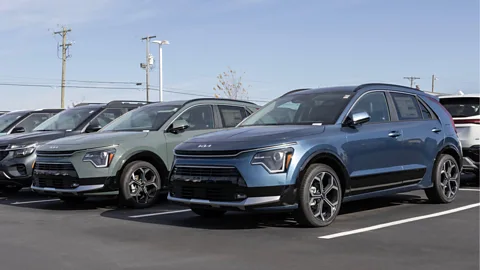'Bridge to full electrification': Could hybrid cars push reluctant drivers to EVs?
 Getty Images
Getty ImagesAs North American consumer uptake of electric vehicles crawls, companies are focusing on upgraded hybrid cars. Will they be baby steps to widespread EV adoption?
After a year of slowed EV adoption in the US left auto giants including Ford with billions of dollars in losses, some car makers are rethinking their business strategies. Instead of pushing an all-electric future onto a consumer worried about where to get their next charge, many are embracing an old-school approach: the hybrid.
Hybrid cars, first introduced to the US at the dawn of the millennium with the Toyota Prius and Honda Insight, are a renewed focus. Some consumers took to these vehicles immediately, and global sales of the Prius peaked in 2012, yet adoption dropped in recent years amid a shift in consumer preferences for large SUVs and pickup trucks over smaller cars. However, companies have introduced a wider array of hybrid vehicles into their already beloved fleets – think Jeep, which offers the popular plug-in hybrid model, the 4xe.
Showcasing these vehicles could be a good strategy for auto companies, who are finding that consumers are interested in more efficient cars, yet still not ready to take the jump to full EVs. They can serve as a toe-in-the-water approach for electric-curious consumers, to eventually get them comfortable enough to make the switch.
Some data shows drivers are already expressing increasing interest in hybrids. Honda, which is one of the highest volume manufacturers of internal combustion engines in the world, says half of its best-selling cars, the Accord and CR-V, are now hybrids. That's up from 8%-to-10% in the past few years, according to Chris Martin, Honda's regulatory, legal and technology communications manager in the US.
 Getty Images
Getty ImagesThe company, which has a goal of electrifying all its vehicles by 2040 as it pursues net zero carbon emissions by 2050, is meeting consumer demand with more hybrid options. Honda sees hybrids as an opportunity to help drivers with internal combustion engines lower emissions in the short term, while also having a positive experience on their electric platform with superior performance and stunning fuel economy – up to 600 miles (966km) for some models. This is a significant improvement over many fully electric vehicles, which only offer half the range (a major barrier for EV adoption for North American consumers).
Once comfortable with the technology, the hope is consumers will want to transition to the more planet-friendly all-electric vehicle. In the case of the soon-to-be released Prologue EV, Honda is betting that hundreds of thousands of Accord and CR-V hybrid owners will take the leap.
Similarly, Kia's hybrids are playing an important role in its electrified strategy. Backed by a $25bn (£19.8bn) investment, the company is offering a range of electrification options across its lines, like with the Niro, which is available in an EV, hybrid and plug-in. "It's a nice bridge to full electrification for people who can't charge at home or at work," James Bell, a spokesperson for Kia America, told the BBC at CES 2024.
Stellantis is also leveraging its hybrids to transition its customer base to EVs. "We have the best-selling plug-in," says global energy and charging senior vice president Ricardo Stamatti, referring to the hybrid Jeep 4xe. They are simultaneously introducing the all-EV Jeep Recon and Jeep Wagoneer S to its 4xe line-up this year, which could be a potential next step for consumers.
 Alamy
AlamyThe faster the transition to EVs, the better for the environment. However, a slower uptake may also provide the window to develop better infrastructure to support a massive fleet of EVs on the road.
With one of the most cited roadblocks to EV adoption being lack of adequate fast-charging, competitors Honda, Kia, Hyundai, Stellantis, Mercedes-Benz, BMW and General Motors joined forces last summer to form a consortium to build more than 30,000 high-powered DC stations across North America by 2030. Other initiatives both on the local and federal levels in countries including the US and Canada are moving along the installation of charging infrastructure, too, though it will take time.
These changes can potentially pave a pathway to the consumer confidence drivers need to take that final step to go fully electric, especially as EV costs are expected to come down throughout the next few years, which has also been a consumer concern. Akshay Singh, automotive partner at global strategy-consulting firm PwC, expects EV adoption to take off around 2026 and 2027.
This all could spell good news for a future EV transition. However, depending on how consumers react to these new hybrid offerings, it's also possible that these models may become a regular presence on the road or the long haul.
